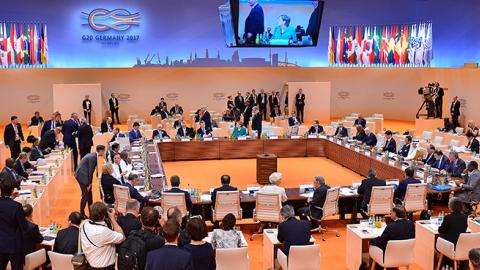The captains and the kings depart, the flames in Hamburg gutter out, and the clouds of oily smoke and tear gas slowly disperse. Another Group of 20 summit has come and gone, and yet again the world has failed to change.
This should not come as a surprise; global summits are almost always empty exercises in public relations. They survive only to make politicians look good. Incumbent presidents and prime ministers strut before the cameras, hoping to look like leaders and statesmen in contrast to their political rivals back home. Egos in wannabe powers are stroked, as the world’s great powers pretend to take them seriously for a few days. There are gassy dinners and gassier communiqués that mean nothing and achieve nothing, yet are haggled over line by line before falling into the oblivion that will entomb them forever.
Will any country change its trade policy as a result of anything in the G-20 communiqué? Will any country change its environmental policies as a result of anything said there? Will any serious historian 50 years from now—or even five—have even the slightest interest in anything the summit produced? Will any of the leaders who signed the communiqué spend five minutes thinking about how to implement it back home?
The answer to all of these questions is, almost certainly, no. All other G-20 summits were forgotten before the last leader returned home; this one is no exception. The world is not governed, or even significantly influenced, by a committee of 20 presidents and prime ministers signing vaguely worded statements with no binding force; history is not made by communiqué.
Great powers, on the other hand, do make history, and even as the hollow rituals of G-20 summitry unrolled, the great and the near-great powers were busy. The rising tension over North Korea’s missile program drove a flurry of Asia-centric diplomacy as the U.S., China, Russia, South Korea, India and Japan explored their options in closed bilateral sessions. Judging from its rhetoric, the Trump administration appears to believe its diplomatic options on this issue are rapidly disappearing. China so far refuses to impose the kind of isolation on North Korea that could threaten the regime’s existence, and Russian missile specialists are reported to be helping North Korea’s current efforts.
President Trump is looking at a set of bad options: capitulation or a bout of coercive diplomacy that involves the threat of war. Whether the Trump administration restrains North Korea or acquiesces in its nuclear and missile program for want of alternatives, Northeast Asia is moving toward its most important strategic realignment since the Communist conquest of China.
Forestalling a war between the U.S. and North Korea is not, unfortunately, the only major challenge the administration faces. Russia, China and Iran, the big three revisionist powers, spent the Obama administration chipping away at world order, and their efforts and those of their smaller sidekicks (like North Korea) have begun to pay off. From Ukraine to the Balkans, Europe has become less stable; the Middle East is a cauldron of conflict and hate. ISIS may be losing territory, but its violent ideology is gaining ground. We do not know where the challenges will come or what form they will take, but the Trump administration is likely to face much sterner international tests than anything President Obama saw.
This is not good news. Barring a Pearl Harbor or 9/11 type of attack—and perhaps even under those circumstances—the Trump administration would begin a conflict with a hostile, deeply skeptical press and with much of the public leaning toward blaming the U.S. rather than its opponents for the crisis. Potential enemies are well aware that American public opinion is the Achilles’ heel of an otherwise nearly invincible American military machine.
Foreigners see a beleaguered American president, a press in full Watergate mode, and a public that is weary of engagement overseas. Across the globe, America’s competitors are thinking about how they can use this moment to advance their own agendas. America’s allies wonder whether they can continue to count on the U.S. for their security. America’s adversaries and potential adversaries are mulling how U.S. weakness can best be exploited.
This combination of American disunity and growing world instability, not the language of the G-20 final communiqué, is driving world history today. This is what our politicians and our officials ought to be thinking about. This, not parsing the body language of world leaders at a vacuous meet-and-greet, is what the press should be covering. This is what could make the difference between peace and war. This is what anyone seriously interested in putting America first and making it great again needs to address.


















